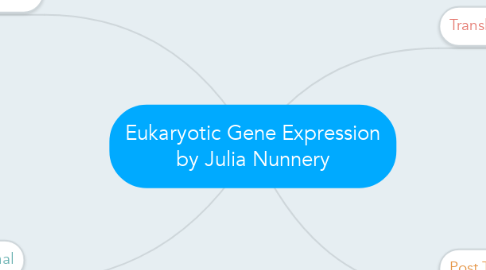
1. Transcriptional
1.1. Initiation
1.1.1. RNA polymerase must bind to promoter
1.1.1.1. Requires assistance of transcription factors
1.2. Prevents
1.2.1. Methylation
1.2.1.1. Condensed chromatin inhibits transcription, silences DNA temporarily
1.3. Promotes
1.3.1. Acetylation
1.3.1.1. Promotes loosening of chromatin and permits transcription, removes acetyl groups
1.3.2. Phosporylation
1.3.2.1. Phosphate next to methyl enacts transcription
2. Post Transcriptional
2.1. Alternative RNA splicing
2.1.1. Different mRNA molecules are produced from same primary transcript
2.1.1.1. Depends which RNA segments are introns and exons
2.2. mRNA degradation
2.2.1. Bacterial mRNA molecules are degraded within minutes of synthesis
2.2.1.1. Causes bacteria to change patterns of protein synthesis and makes bacteria adaptable to changes in environment
2.2.2. Human mRNA may translate protein for hours or weeks
2.2.2.1. Molecules of mRNA in blood cells are stable and can translate hemoglobin molecules for an extended time
3. Translational
3.1. Initiation
3.1.1. Regulatory proteins can attach so ribosomes can't
3.1.2. Translation is under "global control" when stored mRNA are all activated by transcription factors
3.2. miRNA
3.2.1. Single-stranded RNA about 22 nucleotides long
3.2.2. Targets specific mRNA molecules to either degrade them or block their translation
3.3. siRNA
3.3.1. Similar to miRNA in size and function
3.3.2. RNA interference is blocking of gene expression by siRNA
3.4. piRNA
3.4.1. Large class of ncRNAs that guide PIWI proteins to complementary RNAs
3.4.2. Protect germ line cells from attack by transposons
4. Post Translational
4.1. Protein Processing
4.1.1. Proper folding and activation involves attachment or removal of functional groups
4.1.1.1. After insulin is released from a ribosome, it only becomes an active hormone after being cleaved by an enzyme
4.2. Protein Degradation
4.2.1. Ubiquitin marks proteins for destruction then proteasomes degrade them
